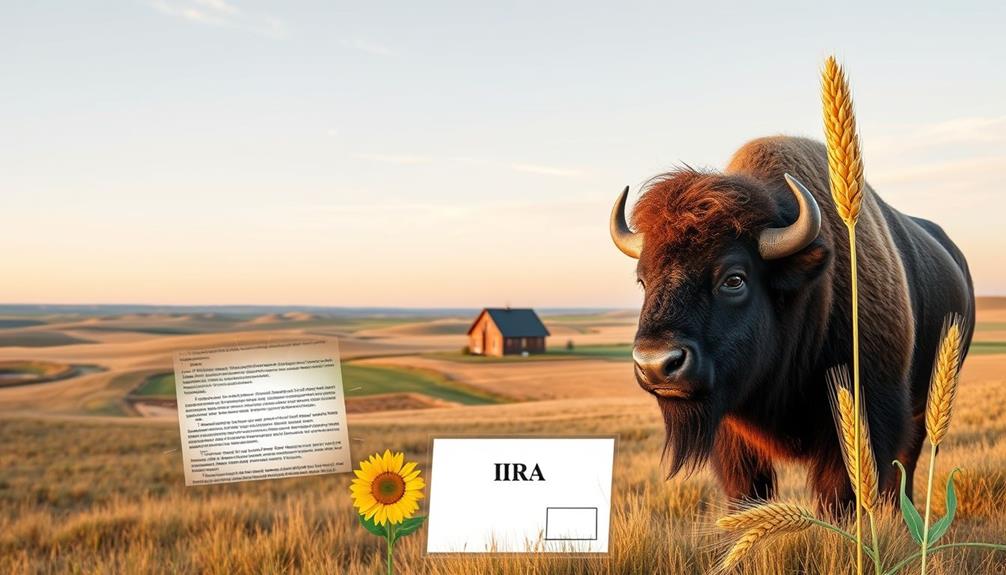When preparing for retirement in South Carolina, it’s important to coordinate your IRAs with state-specific perks for optimal savings. Begin by investing in either a Traditional or Roth IRA, each offering distinct tax benefits based on your circumstances. Remember to consider the South Carolina Retirement System, which offers valuable perks such as the 9% contribution mandate and exclusive retirement exemptions for individuals over 65. By combining these components, you can significantly improve your financial future. Delving into ways to synchronize your IRA plans with state benefits can result in even greater advantages; there is much more to discover on this subject.
Key Takeaways
- South Carolina's retirement systems, SCRS and PORS, offer structured benefits based on years of service and contributions, enhancing retirement savings potential.
- Traditional and Roth IRAs provide diverse tax advantages; traditional IRAs allow pre-tax contributions while Roth IRAs offer tax-free withdrawals.
- Seniors aged 65+ in South Carolina benefit from a $10,000 deduction on retirement income, enhancing overall financial security.
- The South Carolina Deferred Compensation Program (SCDCP) enables additional tax-deferred contributions, complementing IRA savings for active employees.
- Consulting a financial advisor can optimize retirement strategies by integrating IRAs with state-specific benefits for better tax planning and income maximization.
Understanding Retirement Planning

Retirement planning is like building a solid foundation for your future. In South Carolina, understanding the available retirement benefits is vital. One major program you'll encounter is the South Carolina Retirement System (SCRS). As a member, you contribute 9% of your gross pay, which helps fund your future monthly retirement benefits.
These benefits are calculated at 1.82% of your average final compensation multiplied by your years of service, but you need at least five years to become eligible.
Beyond SCRS, you can also leverage tax advantages that South Carolina offers to retirees. For instance, you'll enjoy significant tax deductions on your retirement income, which enhances your overall savings.
It's important to recognize how these state-sponsored plans work alongside individual retirement accounts. By combining SCRS benefits with options like the South Carolina Deferred Compensation Program (SCDCP), you can make additional tax-deferred contributions.
Understanding the eligibility criteria and benefits of both the SCRS and other retirement plans will empower you to maximize your savings. This knowledge is critical for ensuring your financial security and comfort during your retirement years.
Overview of IRAs

When it comes to retirement savings, Individual Retirement Accounts (IRAs) offer you valuable options. You can choose between Traditional and Roth IRAs, each with its own tax advantages and contribution limits.
Additionally, considering a Gold IRA can provide an opportunity for diversification and protection against inflation in a volatile economy, making it an appealing option for many investors looking to IRA Rollover to Gold.
Understanding these types and their benefits is essential for maximizing your retirement strategy in South Carolina.
Types of IRAs
Steering through the world of Individual Retirement Accounts (IRAs) can feel overwhelming, but understanding the options available is essential for your financial future. Among the types of IRAs, Traditional IRAs and Roth IRAs stand out, each with unique benefits tailored to your needs.
| Type of IRA | Key Features |
|---|---|
| Traditional IRA | Pre-tax contributions, tax-deferred growth |
| Roth IRA | Post-tax contributions, tax-free withdrawals |
| Contribution Limit | $7,000 (under 50), $8,000 (50+) |
| Tax Deductions | Possible for Traditional IRAs, not for Roth IRAs |
| Deadline | Contributions until April 15 for previous year |
With a contribution limit of $7,000 for those under 50 and $8,000 for those aged 50 and older, you can maximize your retirement savings. Contributions can be made until the tax filing deadline, allowing you to increase your nest egg. Remember, Traditional IRAs may provide tax deductions based on your income and other factors, while Roth IRAs focus on tax-free growth in retirement. Understanding these types of IRAs will help you make informed decisions for your retirement plan.
Tax Advantages Explained
Understanding the tax advantages of Individual Retirement Accounts (IRAs) can considerably impact your financial strategy. With traditional IRAs, you can enjoy tax benefits by allowing your contributions to grow tax-deferred until you withdraw them.
Additionally, investing in precious metals through a Gold IRA can provide a hedge against inflation and market volatility, enhancing your overall retirement portfolio with a range of investment options. Depending on your income and filing status, you might even qualify for tax deductions on those contributions.
On the other hand, Roth IRAs offer a different angle: contributions are made with after-tax dollars, meaning your withdrawals in retirement are tax-free, provided they meet certain conditions.
As a South Carolina Public Employee, you also benefit from significant state tax deductions on retirement income, including distributions from your IRAs. This feature enhances the overall tax efficiency of your retirement accounts, allowing you to maximize your savings.
Keep in mind that tax implications can vary based on your unique financial situation. It's essential to consult with a tax advisor to guarantee you're optimizing your retirement strategy in line with both federal and South Carolina-specific benefits.
Understanding these tax advantages can help you make informed decisions, ultimately leading to a more secure financial future.
Contribution Limits Overview
Contribution limits for Individual Retirement Accounts (IRAs) play an essential role in shaping your retirement savings strategy. For 2024, the contribution limit is set at $7,000, with an additional catch-up contribution of $1,000 for individuals aged 50 and older.
It's vital to understand how these limits interact with state retirement plans and your overall financial goals, especially if you reflect on diversifying your portfolio with alternative investments like gold IRAs, which can provide a hedge against inflation and market volatility Gold IRAs offer potential benefits.
Here are some key points to reflect on:
- You can contribute to both a Roth IRA and a traditional IRA, but your total contributions can't exceed the annual limit.
- Roth IRAs allow for post-tax contributions, making your withdrawals tax-free in retirement.
- Traditional IRAs involve pre-tax contributions, meaning you'll pay taxes upon withdrawal.
- Keep in mind that income limits apply for Roth IRA contributions, phasing out for singles with a MAGI above $138,000 and married couples above $218,000 in 2024.
Understanding these contribution limits will help you maximize your savings in your Individual Retirement Accounts, ultimately leading to a more secure retirement.
Make sure to review your options regularly, especially as state-specific benefits can also influence your retirement planning.
South Carolina Retirement Systems

In South Carolina, public employees benefit from two primary retirement systems designed to secure their financial future: the South Carolina Retirement System (SCRS) and the Police Officers Retirement System (PORS).
If you're a member of SCRS, you'll contribute 9% of your earnable compensation, while PORS members contribute 9.75%. To qualify for retirement benefits under SCRS, you need at least five years of service; PORS requires a minimum of eight years.
When it comes to retiring, SCRS allows you to retire with an unreduced benefit after 28 years of service or at age 65. PORS members can retire once their age plus years of service equals 90, or at age 65.
Both systems calculate monthly retirement benefits using a formula of 1.82% of your average final compensation multiplied by your years of service, capped with an annual benefit adjustment.
Additionally, consider the South Carolina Deferred Compensation Program (SCDCP) to enhance your savings strategy. It's a great way to make tax-deferred contributions beyond what your state retirement systems offer.
Consulting a financial advisor can help you navigate these options effectively.
Eligibility for State Benefits

To determine your eligibility for state benefits in South Carolina, you'll need to understand the membership class requirements for SCRS or PORS.
Additionally, you'll want to explore retirement income exemptions that may apply to you.
Membership Class Requirements
Understanding the membership class requirements in South Carolina is vital for securing state retirement benefits. The South Carolina Retirement System (SCRS) divides membership into two classes, each with specific eligibility criteria that dictate your retirement programs and benefits.
- Class Two requires a minimum of five years of service for benefits eligibility.
- Class Three necessitates at least eight years for benefits.
- Class Two members can opt for a reduced benefit at age 60 or after 25 years of service.
- Class Three members can retire early with a reduced benefit at age 60.
To enjoy these benefits, your membership must be effective, meaning you need to have compensation from a participating employer.
Class Two members are eligible for an unreduced retirement benefit after 28 years of service or once they reach age 65.
For Class Three members, the unreduced benefit is available when your age plus years of service equals 90 or at age 65.
It's important to maintain active membership and accrue the necessary years of service to secure the retirement benefits you deserve in South Carolina.
Retirement Income Exemptions
Retirees in South Carolina can take advantage of various income exemptions that considerably boost their financial well-being. One of the most beneficial is the Homestead Exemption, which allows homeowners aged 65 and older to exempt the first $50,000 of their home's value from property taxes. This exemption significantly reduces your overall tax burden, providing essential financial relief.
Additionally, South Carolina offers substantial tax deductions on retirement income, including exemptions for Social Security benefits and certain pension payments. These exemptions can enhance your financial stability, allowing you to stretch your retirement savings further.
To qualify for the Homestead Exemption, you'll need to apply through your County Auditor's Office, so make sure you understand the eligibility requirements and deadlines to maximize available benefits.
Furthermore, don't overlook the South Carolina Deferred Compensation Program (SCDCP), which lets active employees contribute additional pre-tax income, further boosting your retirement savings.
Application Process Overview
Maneuvering the application process for state benefits in South Carolina requires a clear understanding of your eligibility. To qualify for retirement benefits, you need to be a member of either the South Carolina Retirement System (SCRS) or the Police Officers Retirement System (PORS).
If you prefer a different option, you must elect to join the State Optional Retirement Program (State ORP) within 30 days of your employment.
Here are some key points to keep in mind:
- If you don't make a choice within the 30-day window, you'll be automatically enrolled in SCRS or PORS.
- To qualify under Class Two membership, you'll need at least five years of earned service; Class Three requires a minimum of eight years.
- Participation in the South Carolina Deferred Compensation Program (SCDCP) offers an additional retirement savings option for active employees.
- Contribution rates are set at 9% for SCRS and State ORP members, while PORS members contribute 9.75%.
Understanding these requirements will help you navigate the state-mandated retirement plans effectively and secure your retirement benefits with confidence.
Contribution Limits and Strategies

When planning for retirement in South Carolina, knowing the contribution limits can greatly impact your long-term savings strategy. In 2024, you can contribute a maximum of $7,000 to your IRA, with an extra $1,000 catch-up option if you're 50 or older. For 401(k) plans, the limit rises to $23,000, plus a $7,500 catch-up provision for those aged 50 and above, allowing for a total of $30,500.
To maximize your retirement savings, consider leveraging state-sponsored retirement plans that often utilize Roth IRA structures for tax-free withdrawals. Here's a quick breakdown of the key contribution limits:
| Account Type | 2024 Contribution Limit |
|---|---|
| Traditional IRA | $7,000 |
| Roth IRA | $7,000 |
| 401(k) | $23,000 |
| 403(b) | $23,000 |
| Catch-Up Contribution | $1,000 (IRA) / $7,500 (401k) |
Monitoring these contribution limits and utilizing catch-up options as you approach retirement age is essential for optimizing your retirement savings.
Maximizing Retirement Income

When it comes to maximizing your retirement income in South Carolina, understanding the tax benefits available to you is essential.
You'll want to strategically plan your withdrawals to guarantee you're making the most of your savings while minimizing tax liabilities.
Tax Benefits Overview
How can retirees in South Carolina maximize their income through tax benefits? By leveraging the state's favorable tax environment, you can greatly enhance your retirement income.
South Carolina offers various tax benefits specifically designed for retirees, allowing you to keep more of your hard-earned money.
- You can benefit from a $10,000 deduction on retirement income if you're 65 or older, which lowers your taxable income.
- Social Security benefits are exempt from state taxes, providing essential financial relief.
- Homeowners aged 65 and older may qualify for property tax exemptions, further reducing your expenses.
- Integrating your IRAs with these state-specific benefits allows for efficient tax planning, minimizing liabilities on withdrawals.
Strategic Withdrawal Planning
Understanding the tax implications of your retirement account withdrawals is essential for maximizing your income in South Carolina. Strategic withdrawal planning can help you minimize tax liabilities while guaranteeing you enjoy a comfortable retirement.
| Account Type | Tax Implications | Recommended Withdrawal Strategy |
|---|---|---|
| IRA | Taxed as ordinary income | Withdraw as needed, consider tax brackets |
| 401(k) | Taxed as ordinary income | Withdraw strategically to avoid higher taxes |
| Roth IRA | Tax-free withdrawals | Withdraw last to maximize tax-free growth |
Utilizing the 4% rule can guide you in estimating sustainable withdrawal rates, helping you project how long your savings will last. It's wise to delay Social Security benefits until age 70 to maximize those monthly payouts. This approach can create a more effective cash flow when integrating your withdrawals from IRAs and other accounts.
Lastly, regularly reviewing your withdrawal strategy based on market performance, your spending needs, and any changes in tax legislation is critical. This ongoing evaluation guarantees you maintain long-term financial stability and maximize your retirement income in South Carolina.
Benefits of Integrating IRAs

Integrating IRAs into your retirement planning in South Carolina can greatly enhance your financial strategy. By combining IRAs with state-specific benefits, you can leverage significant tax advantages and optimize your retirement savings. Contributions to Roth IRAs are made post-tax, while traditional IRAs can provide tax-deductible contributions based on your income level.
Here are some key benefits of this integration:
- Enhanced Savings: Utilizing IRAs alongside the South Carolina Retirement System (SCRS) enables compounded growth, boosting your overall retirement funds.
- Tax Efficiency: South Carolina offers substantial tax deductions on retirement income, allowing you to minimize your taxable income during retirement.
- Property Tax Breaks: The state's favorable property tax breaks for seniors can complement your IRA withdrawals, providing additional financial relief.
- Supplemental Savings: Accessing the South Carolina Deferred Compensation Program (SCDCP) allows you to further increase your retirement savings alongside your IRA contributions.
Financial Advisor Consultation

While maximizing your IRA benefits is important, consulting a financial advisor can take your retirement planning in South Carolina to the next level. These professionals can help you understand how to integrate state benefits, like the South Carolina Retirement System (SCRS) and the South Carolina Deferred Compensation Program (SCDCP), with your individual retirement accounts (IRAs) for ideal savings.
Financial advisors provide guidance on maximizing contributions to both state-sponsored plans and IRAs, ensuring you capitalize on tax advantages and meet contribution limits. For instance, in 2024, you can contribute up to $7,000 if you're aged 50 or over.
They can also evaluate the benefits of different retirement plans, such as the 403(b) Program, which allows contributions up to 85% of your wages.
Engaging a financial advisor can help you navigate the complexities of retirement planning, including the implications of withdrawing funds from IRAs and how it may impact your state benefits.
Furthermore, they can offer insights into combining various retirement savings vehicles, potentially increasing your overall retirement income while adhering to South Carolina's retirement regulations. Investing in expert advice could greatly enhance your financial future.
State-Specific Retirement Resources

When planning for retirement in South Carolina, it's essential to explore the state's specific resources that can enhance your financial security. South Carolina offers a variety of state benefits tailored to meet the needs of retirees, ensuring you can enjoy your golden years without financial stress.
Here are some key resources to evaluate:
- South Carolina Retirement System (SCRS): Join this system by contributing 9% of your earnable compensation for a solid retirement plan.
- Deferred Compensation Program (SCDCP): This program provides active employees with additional savings options alongside their state retirement plans.
- Homestead Exemption: If you're 65 or older, this benefit reduces property taxes on the first $50,000 of your home value, providing much-needed financial relief.
- USC Supplemental Retirement Benefits: Take advantage of a 403(b) tax-sheltered annuity plan with a contribution limit of 85% of your wages, allowing for extra retirement savings.
Planning for Healthcare Costs

As you approach retirement in South Carolina, understanding and planning for healthcare costs becomes essential. The average couple aged 65 can expect to spend around $300,000 on healthcare throughout retirement, excluding long-term care. While Medicare covers many expenses, you should still anticipate out-of-pocket costs averaging $5,000 per person annually, including premiums, deductibles, and copayments.
To better manage your healthcare expenses, consider the following options:
| Option | Details |
|---|---|
| Medicare Advantage | Average monthly premium: $18 (2023) |
| Medicaid | Assists with long-term care costs |
| Health Savings Accounts (HSAs) | Pre-tax savings for medical expenses |
Additionally, South Carolina's Medicaid program can help cover long-term care costs, though qualifying can be complex due to income and asset limits. If you're eligible, Health Savings Accounts (HSAs) offer significant tax advantages, allowing you to save pre-tax dollars for qualified medical expenses. By integrating these options into your retirement plan, you can effectively manage healthcare costs and guarantee a healthier financial future.
Frequently Asked Questions
Does South Carolina Have State Income Tax on IRA Distributions?
Yes, South Carolina does impose state income tax on IRA distributions. However, retirees can benefit from significant deductions, with a $10,000 deduction for those 65 and older, easing the tax burden on your retirement income.
Is South Carolina a Tax-Friendly State for Retirees?
Yes, South Carolina's tax policies are quite favorable for retirees. You'll benefit from exemptions on Social Security income, deductions for other retirement income, and no estate taxes, making it a financially appealing state for retirement.
Can You Combine State and Federal Retirement?
Did you know that nearly 70% of retirees combine state and federal retirement accounts? Yes, you can combine them! This strategy boosts your savings, maximizing tax benefits and income potential for a more secure future.
How Does the SC State Retirement Plan Work?
The South Carolina retirement plan requires you to serve at least five years for Class Two or eight for Class Three. You contribute 9% of your pay, earning interest until you retire. Benefits depend on your service years.
Conclusion
In South Carolina, effective retirement planning means more than just saving; it's about weaving together your IRAs with state-specific benefits. By understanding how these elements interact, you can create a thorough strategy that maximizes your financial security. Remember, integrating your retirement accounts isn't just a smart move—it's essential for peace of mind. So, take the time to explore your options, consult a financial advisor, and guarantee you're well-prepared for the future ahead.









